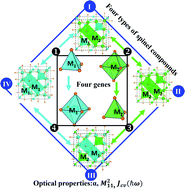Inverse design of stable spinel compounds with high optical absorption via materials genome engineering†
Abstract
Conventional semiconductors, e.g., Si and GaAs with tetrahedral coordination (four-fold) structures, possess good stability but relatively low optical absorption compared with halide perovskites with octahedral coordination (six-fold) structures, which exhibit superior optical absorption but relatively poor stability. It is thus desirable to combine the complementary properties of four-fold and six-fold semiconductors to have a system with both good stability and optical absorption. To achieve such a goal, we investigate the spinel compounds AB2X4 (X = O, S and Se) as potential candidates because they possess both four-fold and six-fold coordination in one structure. Here, we built four basic structure units as material genes to design various types of spinel compounds with optimal optical absorption. The optical absorption of a semiconductor (α) is fundamentally determined by the dipole transition matrix element (|M|2) and joint density of states (Jcv). Our first-principles calculations show that in AB2X4 systems the type of cation at the B site determines the optical absorption. Two rules are identified through our study: (i) the sv cations with the valence s orbital at the valence band maximum at the B site (type-I, type-II) will lead to allowed transitions, whereas the sc cations with the valence s orbital at the conduction band minimum at the B site (type-III, type-IV) will lead to partially forbidden or fully forbidden transitions; (ii) when the sv cation is located at the B site, the A site with the sc cations (type-I) has higher |M|2, while the A site with the sv cations (type-II) has higher Jcv. Our study, therefore, provides guidelines to optimize the Jcv and |M|2, and thus α, through cation engineering in AB2X4 compounds, which have higher stability compared to that of halide perovskites.



 Please wait while we load your content...
Please wait while we load your content...